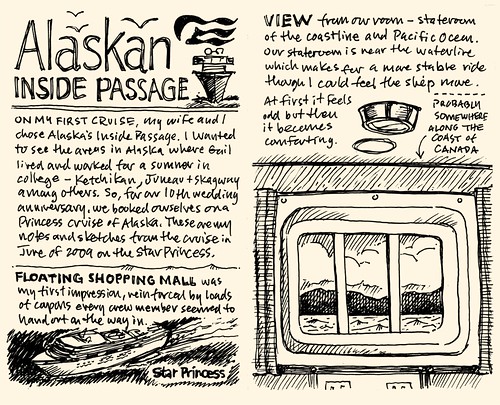A lot of artists like to take their art supplies with them when they travel. For some, the joy they get from creating art on the road more than makes up for the inconvenience of lugging all of their supplies. For others, they come up with creative ways to lighten their load, carrying fewer things and packing everything into a very portable artist kit.
And then there are people like me. As much as I like to draw, my work more closely resembles doodles, and it’s rarely worth my trouble to pack any meaningful art supplies. Usually, the most I take with me might be a pocket sketchbook, a Sharpie pen, a mechanical pencil, and an eraser. Sometimes I take more, sometimes less.
However, I recently discovered a great little item that I’ve since incorporated as a regular item in my mini art kit: the Pentel 8-Color Pencil.
If you’ve ever come across a “stacking crayon,” you know how convenient those things are. There are a couple of different styles, but they all provide multiple colors of crayon tips that snap into a single pen holder, giving you a complete palette in a tiny bit of space.
The biggest issue with these is that they are designed primarily for kids to play around with. So the crayon quality is rather poor. Add to that, the fact that these mechanical crayon pencils only offer TIPS of each color; once you’ve drawn a picture or two, you’ve run out of color.
The Pentel 8-Color Pencil is completely different from these kid’s toys. It’s a mechanical pencil that has eight slots, with each housing a different color lead the length of a regular mechanical pencil lead. On top of that, the slots are refillable; you can buy lead refills for this pencil, just like you can for regular mechanical pencils.
If you’ve ever used a multi-point retractable pen (like the iconic Big 4-color ballpoint pen, or the more recent offerings from companies like Pilot and Uniball), the Pentel 8-Color Pencil works exactly the same way.
The 8-Color Pencil isn’t too heavy, although there is enough heft to it that you feel like you are drawing with a real instrument. There is no pen cap, since this is a retractable. To release lead out from the tip, just press down on the top button. The lead doesn’t feed down in measured segments like some mechanical pencils; holding down the top button just releases the lead, so you will want to be ready to catch it to prevent the whole thing from sliding out.
The colored leads feel pretty good. They feel a little softer than regular colored pencil lead, but they don’t feel at all mushy like crayon lead feels. The lead is each 2.0mm thick, which draws pretty thick lines. In fact, this actually makes a pretty good highlighter marker, esp with some of the lighter colors like yellow and pink. It might actually be better than pen highlighter markers on glossy surfaces, since the pencil wouldn’t cause any ink bleed.
If you’ve always wanted to sit down and sketch a scene during your travels but never wanted to bother with taking a box of colored pencils, this is the item to get.
The only down side? It’s a little pricey. Pentel sells it online for $24.48, although you can look around online (including eBay) and save a few bucks.
8-Color Pencil Model PH158
2.00mm pencil lead in red, blue, brown, orange, yellow, light green, pink, and light blue. Refillable with Pentel CH2 lead.
Available directly from Pentel for $24.84 or from Amazon for under $20.
Manufactured by Pentel









